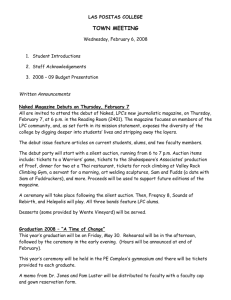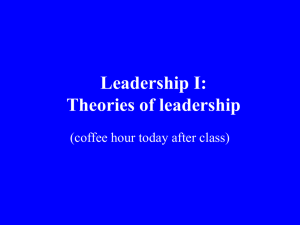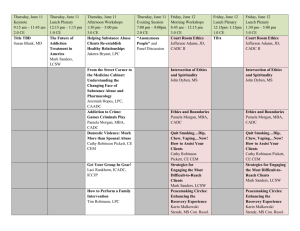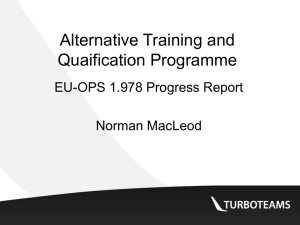Setting Context, Assessing Trends, Forecasting the Future
advertisement
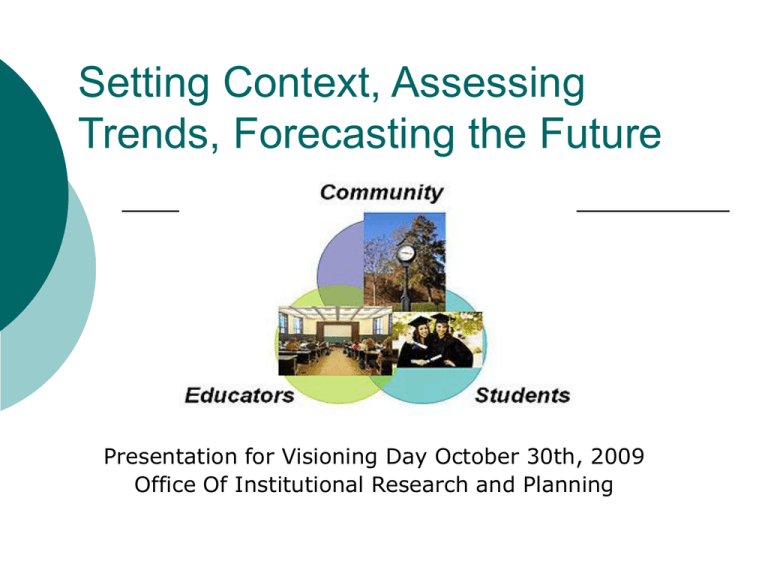
Setting Context, Assessing Trends, Forecasting the Future Presentation for Visioning Day October 30th, 2009 Office Of Institutional Research and Planning Setting Context, Assessing Trends, Forecasting the Future For Planning purposes data can help you do three things Set goals by identifying trends, problems, strengths, opportunities Inform Strategies by understanding the cause of problems or logistical considerations Evaluate progress and make corrections Setting Context, Assessing Trends, Forecasting the Future But data is just small part. While data-jockeying is important it’s the syntheses, analysis, application and evaluation of data and information that is at the core of what we need to do. Setting Context, Assessing Trends, Forecasting the Future External: Demographic/workforce forecasts K-12 trends UC/CSU trends Public perceptions of Higher Education Setting Context, Assessing Trends, Forecasting the Future Internal Student Demographics Student Preparation Student Success and Learning Setting Context, Assessing Trends, Forecasting the Future Shifting Forces Workforce/Skills Gap Economy (short and long term) Funding and Legislation Sustainability Increased Diversity Globalism Changes in the Nature of Learning and the Millennial generation External: Demographics Population Growth Population 2010 2019/2020 ABAG 31,600 3.7% 15.9% 120,288 156,100 8.2% 10.1% 500,671 541,400 9.8% 10.3% 13.7% n/a ABAG EMSI 175,303 198,300 181,764 229,900 6,461 Alameda County 1,466,636 1,549,800 1,586,924 1,705,900 Regional Area (for jobs): Alameda, Countra Costa, San Francisco, and Santa Clara 5,090,282 5,272,100 5,590,953 5,813,500 37,696,392 n/a 42,854,241 State of California EMSI: Economic Modeling Specialists, Inc. ABAG: Association of Bay Area Governments n/a % Change from 2010 to 2020 EMSI EMSI Local Area (for students): Dublin, Livermore, Pleasanton, Sunol ABAG Change from 2010 to 2020 EMSI 5,157,849 ABAG n/a External: Demographics Projected Race/Ethnicity Demographics Over Time by Area 100% 7000 1263 80% 1347 424 60% 196619 4,535,812 29,210 8,257 43,053 1240644 1,286,206 2,239,807 371,094 7683 218677 5,130,819 32,883 7,832 47,655 1,437,510 2,299,101 8613 246828 5,783,680 36,927 7,767 1,612,525 53,500 2,374,111 17,406,928 1,213,358 Black or African American Hispanic 1,367,920 40% 130,654 20% 123,057 4581 2,057,917 15,574,287 119,308 1,971,052 15,464,121 1,933,675 15,420,158 Source: EMSI data 2013 2018 State Counties Cities State Counties Cities State Counties Cities LPC 0% 2008 Other 364,054 15,303,908 1,158,020 1587523 Asian 361,293 13,394,509 1407 1402884 White, NonHispanic External: Labor/Jobs Growth Labor/Jobs 2010 EMSI 2019/2020 ABAG EMSI ABAG Change from 2010 to 2020 EMSI ABAG % Change from 2010 to 2020 EMSI ABAG Local Area (for students): Dublin, Livermore, Pleasanton, Sunol 152,829 105,970 164,735 133,400 11,906 27,430 7.8% 25.9% Alameda County 888,167 712,850 965,567 825,070 77,400 112,220 8.7% 15.7% Regional Area (for jobs): Alameda, Countra Costa, San Francisco, and Santa Clara 3,284,29 6 2,564,570 3,654,481 2,989,790 370,185 425,220 11.3% 16.6% State of California 20,696,4 99 n/a 23,140,653 11.8% n/a EMSI: Economic Modeling Specialists, Inc. ABAG: Association of Bay Area Governments n/a 2,444,1 54 n/a External: Labor Top 10 Occupations with Greatest Growth (by N) in Four-County Area: 2008 - 2018 Education: Associate Degree 5,000 4,500 4,423 4,000 3,500 3,000 2,500 2,000 1,500 1,021 1,000 879 878 476 500 402 172 170 170 152 Medical records and health information technicians ($20/hr) Interior designers ($22/hr) Veterinary technologists and technicians ($19/hr) Respiratory therapists ($36/hr) 0 Registered nurses ($49/hr) Computer support specialists ($27/hr) Source: EMSI data Computer Paralegals and specialists, all legal other ($39/hr) assistants ($29/hr) Dental hygienists ($49/hr) Biological technicians ($21/hr) External: Labor Top 10 Occupations with Greatest Growth (by N) in Four-County Area: 2008 - 2018 Education: Bachelor's Degree 8,000 7,215 6,511 7,000 6,000 5,000 3,670 4,000 2,582 3,000 2,528 2,481 2,421 2,171 1,361 2,000 1,305 1,000 0 Property, real estate, and community association managers ($11/hr) Computer software engineers, applications ($48/hr) Source: EMSI data Computer Network systems Computer Business Accountants and Personal financial Network and Elementary software and data systems operation auditors ($29/hr) advisors ($30/hr) computer school teachers, engineers, communications analysts ($39/hr) specialists, all systems except special systems software analysts ($36/hr) other ($34/hr) administrators education ($51/hr) ($41/hr) ($38/hr) External: k-12 trends College Going rates Statewide it’s decreasing-locally it’s higher Increased Gap between haves and have nots (achievement Gap) Exit exam Increased ESL population Math: Algebra in 8th grade External: k-12 trends Concerns over Curriculum gap between high school and College Cal-Pass research shows students often repeat course in college they already took in high school This may partly explain why it seems that so many high school graduates are unprepared for college level work. External: k-12 College Going Rates Las Positas High School Districts No Public College 33% UC 10% CSU 17% CCC 40% Source: California Department of Education External: k-12 Source of First-Time Freshman to Las Positas College Other California High Schools, 24% Other Bay Area High Schools, 6% Out of State High Schools, 4% High Schools in Other Countries, 5% Other Alameda County High Schools, 3% High Schools in Chabot District, 8% Source: CLPCCD Institutional Data Base High Schools in LPC District, 50% Internal: Local High Schools HS Grad Year LPC Semester Number of Grads* Number New Enrollments at LPC Grad year the previous Spring** % of grads who attended LPC the Fall after HS Graduation Number of New Enrollments at LPC of any Grad Year** % of New LPC Students who graduated HS any year Number of All New Students to LPC** 1996-1997 Fall 1997 1658 356 21% 494 44% 1112 1997-1998 Fall 1998 1714 391 23% 512 45% 1126 1998-1999 Fall 1999 1869 446 24% 551 49% 1131 1999-2000 Fall 2000 1804 576 32% 709 51% 1403 2000-2001 Fall 2001 1912 588 31% 707 51% 1385 2001-2002 Fall 2002 2048 655 32% 779 54% 1456 2002-2003 Fall 2003 1916 646 34% 785 53% 1470 2003-2004 Fall 2004 2200 698 32% 834 55% 1516 2004-2005 Fall 2005 2293 684 30% 811 52% 1556 2005-2006 Fall 2006 2380 645 27% 907 50% 1606 2006-2007 Fall 2007 2517 767 30% 911 51% 1769 2007-2008 Fall 2008 2637 763 29% 926 52% 1767 External: UC/CSU Less capacity/budget cuts More competition Higher fees External: Public Perception (Clarus Report) Market Assessment Report (March 2007) The name and existence of LPC is well known 55% of LPC service area would consider attending LPC Considered convenient and affordable Generally well regarded but public lack specific knowledge External: Public Perception (Campus Commons Report) Public Feel a college education is necessary and fear that increasing costs make college out of reach Support of high education is contingent on maintaining access Growing sense that colleges are inefficient and can educate more students without needing more money External: Summary Demographic Continued growth and increased diversity Workforce Increase in jobs outpace growth in population Healthcare, technology, business/finance Must anticipate areas of growth and be nimble enough to quickly respond to needs External: Summary K-12 trends We draw students for all over…not just our local high schools Almost half of local high school graduates attend LPC Must understand and respond to trends such as achievement gap, differences curriculum and student preparation Public Perceptions of Higher Education/LPC In general, growing sense that colleges are inefficient and can educate more students without needing more money. LPC is generally well regarded but public lack specific knowledge LPC Internal: Demographics 30000 LPC Headcounts and Enrollments Fall 1999-Fall 2009 27,360 29,235 25,418 25000 23,182 22,376 20000 18,287 19,127 20,710 20,951 20,847 20,223 15000 Headcount Enrollments 10000 5000 6951 7413 7857 8588 7395 7325 7332 7796 8451 Fall 2005 Fall 2006 Fall 2007 9100 9517 Fall 2008 Fall 2009 0 Fall 1999 Fall 2000 Fall 2001 Fall 2002 Fall 2003 Fall 2004 Internal: Demographics LPC Number of Units Fall 1999-Fall 2009 100% 90% 47% 48% 47% 46% 39% 38% 36% 36% 35% 34% 32% 80% 70% 60% 27% 26% 26% 26% 29% 28% 29% 27% 28% 29% 29% up to50% 5.5 Units 5.6-11.9 40% Units 12 or more 30% Units 26% 27% 27% 29% 31% 34% 34% 37% 32% 36% 38% 20% 10% 0% Fall 1999 Fall 2000 Fall 2001 Fall 2002 Fall 2003 Fall 2004 Fall 2005 Fall 2006 Fall 2007 Fall 2008 Fall 2009 Internal: Demographics LPC Age Distribution Fall 1999- Fall 2009 100% 90% 80% 70% 12% 12% 12% 13% 11% 11% 11% 10% 10% 10% 10% 12% 12% 12% 12% 11% 11% 10% 10% 10% 9% 9% 12% 11% 11% 10% 11% 10% 14% 9% 10% 10% 9% 11% 9% 28% 29% 28% 31% 16% 16% 16% 60% 10% 10% 50% 40% 23% 24% 10% 23% 14% 9% 9% 50 or older 40-49 24% 27% 28% 27% 30-39 30% 25-29 20% 20-24 10% 27% 27% 26% 28% 28% 30% Fall 1999 Fall 2000 Fall 2001 Fall 2002 Fall 2003 Fall 2004 31% 31% 32% 31% 31% 19 or younger 0% Fall 2005 Fall 2006 Fall 2007 Fall 2008 Fall 2009 Internal: Demographics LPC Student Type Fall 1999-Fall 2009 100% 90% 80% 3% 11% 13% 4% 6% 21% 5% 5% 21% 5% 5% 1% 4% 4% 4% 1% 2% 1% 2% 2% 1% 19% 22% 22% 22% 21% 21% 20% 21% 70% 60% 50% 40% 56% 53% 54% 55% 56% 56% 57% 56% 52% 51% 52% 16% 18% 17% 17% 19% 21% 21% 20% 21% 20% 21% Fall 1999 Fall 2000 Fall 2001 Fall 2002 Fall 2003 Fall 2004 Fall 2005 Fall 2006 Fall 2007 Fall 2008 Fall 2009 30% 20% 10% 0% Enrolled in K-12 Returning Student Transfer-In Students Continuing Student New Student Internal: Demographics LPC Educational Goal Fall 1999-Fall 2009 100% 90% 24% 23% 23% 24% 22% 21% 9% 8% 22% 21% 21% 9% 8% 8% 80% 70% 9% 60% 17% 50% 10% 40% 10% 9% 17% 9% 10% 10% 18% 9% 10% 11% 19% 18% 6% 6% Goal undecided 15% 15% 15% 15% 15% 15% 8% 8% 16% 9% 10% 11% 12% 9% 9% 10% 12% 13% 16% 7% 7% 14% 13% 30% 32% 30% 30% job related goal 12% Two year assoc without transfr 30% 20% Intellectual/cultur al dev. 34% 34% 33% 35% 36% 39% 40% 10% BA without completing AA BA after completing AA 0% Fall 1999 Fall 2000 Fall 2001 Fall 2002 Fall 2003 Fall 2004 Fall 2005 Fall 2006 Fall 2007 Fall 2008 Fall 2009 Internal: Demographics LPC Race/Ethnicity Fall 1999-Fall 2009 100% 90% 3% 6% 3% 7% 3% 8% 3% 8% 3% 8% 3% 9% 4% 9% 3% 10% 3% 11% 4% 11% 4% 11% 11% 12% 12% 12% 13% 13% 14% 15% 16% 16% 17% 80% 70% 60% African American 50% Asian 70% 40% 68% 66% 66% 64% 62% 59% 56% 54% 52% 53% Hispanic 30% White 20% 10% 10% 10% 11% 11% 12% 13% 14% 16% 16% 17% 15% Fall 1999 Fall 2000 Fall 2001 Fall 2002 Fall 2003 Fall 2004 Fall 2005 Fall 2006 Fall 2007 Fall 2008 Fall 2009 0% Other unknown Internal: Demographics Growth in enrollment Traditional college students (fulltime, young, goal to transfer, never attended college) Increasing racial/ethnic diversity (Asian and Hispanic populations) Internal: Student Preparation Las Positas English Assessment Trends Fall 1998-Fall 2008 College Level: Engl 1A 1 Below: Engl 101A/104 Pct. Assessing into Each Level 2 Below: Engl 116-Learning Skills 3 Below: Take ESL Test 100% 80% 60% 40% 20% 0% 1998 1999 2000 2001 2002 2003 Year 2004 2005 2006 2007 2008 Internal: Student Preparation Las Positas Math Assessment Trends Fall 1998-Fall 2008 College Level: Trig or above 1 Below: Math 55/55A Int. Alg. 2 Below: Math 65/65A Elem. Alg. 3 Below: Math 107 Basic Skills % Assessing into Each Level 50% 40% 30% 20% 10% 0% 1998 1999 2000 2001 2002 2003 Year 2004 2005 2006 2007 2008 Internal: Student Preparation Increase in number and proportion of students who require basic skills courses in English and Math (and study skills) Simultaneous increase in students who have high education goals and expect academic rigor in preparation for transfer Internal: Success and Leaning -Transfers Top Six Four-Year Colleges and Universities Transfers 180 160 140 UC Berkeley UC Davis 120 CSU East Bay CSU Sacramento 100 San Francisco State San Jose State 80 60 40 20 0 19981999 19992000 20002001 20012002 20022003 20032004 20042005 20052006 20062007 20072008 Internal: Success and Learning-Income Increase in Personal Income After Graduating from a CCC in 2000-01 $60,000 $50,000 $40,000 $30,000 $20,000 $10,000 $0 1998 1999 2000 CA Median Household Income Source: ARCC Report www.cccco.edu 2001 2002 CA Per Capita Income 2003 2004 CCC Median Income Internal: Student Success and Learning Core Competencies Communication Critical Thinking Creativity and Aesthetics Respect and Responsibility Technology Measured in a number of ways including inclass assessments and Student Self reports Internal: Student Success and Learning Greatest Self-Reported Gains Mean Skills I can use in my current or future career 3.89 Discovering my own potential 3.84 Developing clear career goals 3.83 Writing Skills 3.79 Gathering information from multiple sources 3.79 Ability to learn on my own, pursue ideas and find info. 3.79 Performing to the best of my abilities 3.78 Understanding myself- abilities, interests, limitations 3.78 Critical thinking 3.75 Listening effectively 3.72 Applying knowledge to new situations to solve problems 3.72 Ability to set goals and develop strategies to reach them 3.72 1 = Much Weaker, 2= Weaker, 3 = No change, 4 = Stronger, 5 = Much Stronger Internal: Student Success and Learning Lowest Self-Reported Gains Mean Awareness of my civic or community responsibilities 3.48 Appreciation for the arts and the role art plays in society 3.49 Using numerical data 3.49 Appreciation of my role in a democratic society 3.52 Overall technological literacy 3.54 Desire to contribute to my community/society 3.55 Ability to use computers effectively 3.56 Ability to meet challenges of a rapidly-changing society 3.58 Ability to read, interpret, and generate charts/graphs 3.59 Reading skills 3.59 Mathematical skills and abilities 3.60 1 = Much Weaker, 2= Weaker, 3 = No change, 4 = Stronger, 5 = Much Stronger Internal: Summary Student Demographics LPC has a large proportion of “traditional” students (young, transfer directed, full-time) Student Preparation High school students expect high quality education for transfer and workforce training But also need remedial academic and leaning skills support Internal: Summary Student Success and Learning Graduating from a CCC greatly increases earnings. Student report greatest gains is a broad mix of outcomes that range from academic to affective As with highest gains, lowest gain is a broad mix of academic and affective outcomes. Many of the outcomes concerned with civic engagement and societal contribution are areas in which students report fewer gains. Shifting Forces: Workforce Gap Gap of workers qualified and experienced to replace baby boomers Over supply of workers for the number of low skilled jobs Both a demographic and educational trend Shifting Forces: Economy- Short Term o Slow recovery o Lag in creation of jobs (Latest UCLA Anderson Forecast predicts doubledigit unemployment until end of 2011) Shifting Forces: Economy- Long Term Recovery vs. Reset Breaking the law: Okun’s law Growth alone wont save us because the “lost” jobs are not coming back Long term and profound changes in Home ownership, consumer spending/saving, availability of credit, investment, business start-ups (which are the first source of new jobs) Shifting Forces: Economy- Long Term Recovery vs. Reset Different types of jobs/skills Longer term training for higher skills jobs Need to shift away from quick in and out training programs Not so much a “labor” gap; more of a skills gap Shifting Forces: Funding/Legislation Decreased funding* Unreliable funding unless major changes to constitution Term limits 2/3 budget Redistricting Unfunded mandates Shifting Forces: Increased Accountability WASC (Western Association of Schools and Colleges) ARCC (Accountability Reporting for Community Colleges) Increased public scrutiny/sophistication and questioning Less focus on process and more focus on outcomes and results Shifting Forces: Sustainability •Three Bottom Lines Environment Economy Equity / Community Shifting Forces: Sustainability Practices/ Operations -drinking fountains -recycling -building design -solar electric Education -certificates -degrees -transfer programs -Infuse sustainable ideas into curriculum Processes/ Human Resources -sustainable processes -hiring the proper number of support staff -Prioritizing initiatives Shifting Forces: Increased Diversity oGetting Beyond “Quotas” thinking oGetting beyond “meeting the needs of diverse populations” oTransforming who we are and what we do oEssential workplace/life skill for ourselves and our students Shifting Forces: Globalism Increased competition Increased need for ability to understand different perspectives Delivery methods Ability to adapt, change and learning on own Shifting Forces: Nature of Learning Traditional Instructor provides Information Student responsible for mastery Instructor as source of information Millenial Students have access to information Students expect instructor to help them master the information Instructor as learning coach Shifting Forces: Nature of Learning Instructor is valued as source of information Instructor valued as learning coach What would this mean for professional development, delivery methods, curriculum, pedagogy, classroom management? Setting Context, Assessing Trends, Forecasting the Future Data isn’t about what you know...its about how you make sense of it…how you apply it. While important, data is the least interesting part. Analysis, synthesis, evaluation is how the dots get connected.
